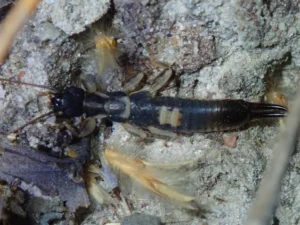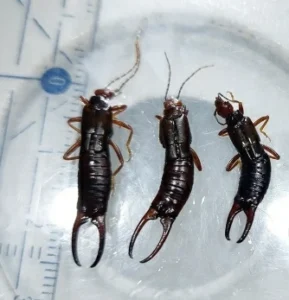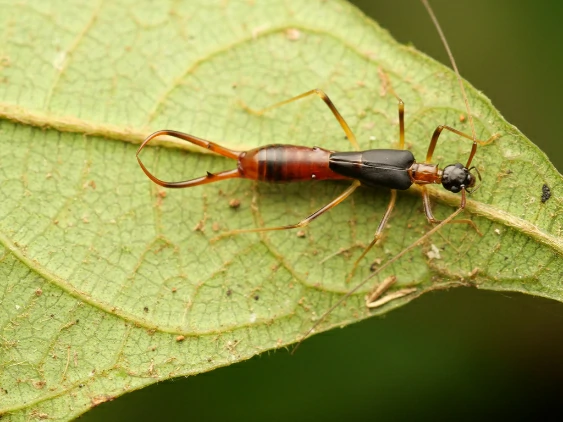Earwigs are small, dark-colored insects known for the pincers on their backs. They’re often found in moist environments under rocks, mulch, or leaf litter, the same places salamanders like to hide. This overlap leads many people to ask: can salamanders eat earwigs?
The short answer is yes. Some salamanders will eat earwigs if the opportunity arises, but earwigs are not a preferred food and are sometimes avoided due to their tough bodies and defensive behavior.
What Are Earwigs?
Earwigs are nocturnal insects that feed on decaying plant material and other insects. They are easily recognized by the forceps-like pincers (called cerci) on their back end.
Despite their appearance, earwigs:
- Do not crawl into people’s ears
- Are not venomous
- Can pinch but rarely cause real harm
They live in dark, damp places, making them common in the same environments where many salamanders are active.

Earwigs have a flattened, elongated body that helps them squeeze into narrow spaces beneath bark, leaves, or stones.
Their brown or black color and small size allow them to blend into the moist ground environment.
Because of this, they share habitats with many salamander species, increasing the chances of interaction between the two.
Why Salamanders Might Eat Earwigs
Salamanders are opportunistic feeders. If an insect moves and fits in their mouth, they may go for it. Earwigs:
- Are similar in size to crickets or beetles
- Move slowly when disturbed
- Have soft enough midsections to be digestible
- Can sometimes be caught at night when both species are active
While not their first choice, some salamanders will eat earwigs if nothing better is available.
Many salamanders rely on movement to detect prey, so slow-moving earwigs may catch their attention.
Although earwigs have a somewhat tough exterior, their softer underbellies make them a suitable food source for species willing to take the risk.
Salamanders living in damp, wooded areas often encounter earwigs naturally. This availability means earwigs can occasionally appear in the wild diet of these amphibians, though they prefer easier or less defensive prey.
Do Earwigs Fight Back?
Yes, to a degree. Earwigs use their pincers to defend themselves. They may try to pinch a salamander or curl up to avoid being swallowed.
In most cases, this isn’t enough to stop a determined salamander. But their defensive behavior may be enough to discourage repeat attempts, especially in smaller salamander species.

Earwig pincers are not strong enough to cause serious harm, but they may cause minor discomfort or annoyance. Some salamanders learn to avoid prey that pinches, preferring softer or less aggressive options.
Additionally, earwigs may release foul-smelling secretions as a defense mechanism. This can make the prey less appetizing and encourage the salamander to spit it out.
Are Earwigs Safe for Salamanders?
For the most part, yes, but with a few cautions:
- Hard shells: Adult earwigs have somewhat tough exoskeletons, which can be harder to digest.
- Defensive secretions: Some earwigs may produce foul-smelling chemicals that could irritate the salamander or make them spit it out.
- Biting behavior: Though minor, earwig pinches could annoy smaller salamanders.
As an occasional wild-caught snack, earwigs are not toxic. But they shouldn’t be a regular part of the diet.
The chitin in the earwig exoskeleton can be difficult to digest in large amounts. Frequent feeding of tough insects may cause digestive issues or discomfort.
Salamanders with sensitive digestive systems or young individuals may have more trouble with earwigs.
Should You Feed Earwigs to Pet Salamanders?
It’s best to avoid it. While not dangerous, earwigs don’t offer much in terms of nutrition compared to safer feeder insects.

In captivity, better choices include:
- Earthworms
- Crickets
- Waxworms
- Flightless fruit flies
- Blackworms or bloodworms (for aquatic species)
These options are softer, easier to digest, and provide more consistent nutrients.
Earwigs also tend to be more active and harder to catch than some feeder insects, making them less practical for regular feeding.
If you do collect wild earwigs to feed, be sure they come from pesticide-free areas and wash them thoroughly before offering to your salamander.
Providing a varied diet is important for maintaining salamander health and encouraging natural feeding behaviors.
What Happens If Your Salamander Eats an Earwig?
If a salamander eats a small earwig, it’s usually not a problem. Most will pass through the digestive system without issue.
Watch for:
- Refusal to eat
- Spitting out the earwig
- Lethargy or bloating (rare)
If your salamander avoids food after eating an earwig, just return to its regular diet and monitor closely.
In most cases, salamanders handle an occasional earwig snack with no negative effects. If any adverse signs appear, consult a veterinarian experienced with amphibians.
Salamanders generally have strong digestive enzymes suited for a variety of insect prey, but individual sensitivity can vary.
Tips for Feeding Insects Safely
When offering live prey, always observe your salamander to make sure it can catch and consume the food easily.
Remove uneaten insects after 15 to 20 minutes to prevent stress or injury to your pet.
Gut-load feeder insects with nutritious food 24 hours before feeding to improve their nutritional value.
Avoid feeding wild-caught insects frequently unless you are confident they are free from pesticides and parasites.
Use feeding tongs if your salamander is shy or slow to hunt. This helps reduce stress and encourages feeding.
Conclusion
Salamanders can eat earwigs, but they are not a preferred food. The hard shell, defensive pinches, and potential secretions make earwigs a less-than-ideal choice.
In the wild, they may be eaten occasionally. In captivity, stick to safer, softer feeder insects for the best health results.
Choosing nutritious, easy-to-digest prey ensures your salamander remains healthy and happy.
Remember, variety is important in a salamander’s diet. Feeding a range of insects and worms provides balanced nutrition and mimics natural feeding habits.
Hi, my name is Ezra Mushala, i have been interested animals all my life. I am the main author and editor here at snakeinformer.com.

